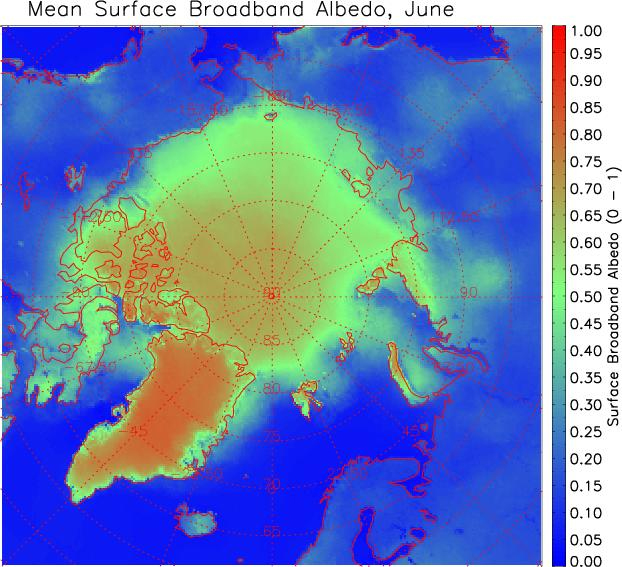SHEBA: Surface Heat Budget of the Arctic Ocean (SHEBA)
SHEBA was motivated by the large discrepancies among simulations by global climate models (GCMs) of the present and future climate in the arctic and by uncertainty about the impact of the Arctic on climate change. These problems arise from an incomplete understanding of the physics of vertical energy exchange within the ocean/ice/atmosphere system. To address this problem, the SHEBA project was focused on enhancing understanding of the key processes that determine ice albedo feedback in the arctic pack ice and on applying this knowledge to improve climate modeling.
The scientific objectives of SHEBA included: (1) Development of accurate physical and mathematical relationships between the state of the ice cover and albedo, for any given incident short-wave radiation (2) Determining how the state of the ice cover changes in response to forcing from the atmosphere and the ocean (3) Relating the surface forcing to conditions within the atmospheric and oceanic boundary layers (4) Extending the relationships determined in Objectives 1-3 from local scales to the aggregate scales suitable for climate models (5) Establishing a basic data set suitable for developing and testing climate models that incorporate the processes SHEBA proposed to study.
From NCAR Earth Observing Laboratory SHEBA project description
Investigators
- Dr. Jeffrey R. Key Cooperative Institute for Meteorological Satellite Studies (CIMSS)
Related Websites
Publications
-
Gultepe, I.; Isaac, G. A.; Key, J.; Intriere, J.; Starr, D. O’C., and Strawbridge, K. B. Dynamical and microphysical characteristics of Arctic clouds using integrated observations collected over SHEBA during the April 1998 FIRE.ACE flights of the Canadian Convair. Meteorology and Atmospheric Physics v.85, no.4, 2004, pp235-263. Reprint #3705.
-
Key, Jeffrey R., Curry, Judith, Evans, Frank, Pinto, James, Maslanik, James, and Steffen, Konrad. Documenting, understanding, and predicting the aggregate surface radiation fluxes for SHEBA. Final report on NASA grant NAG5-8625 (formerly NASA5-4903). Madison, WI, University of Wisconsin-Madison, Space Science and Engineering Center, 2001. 19p. UW SSEC Publication No.01.07.K3.
-
Schweiger, Axel J.; Lindsay, Ronald W.; Francis, Jennifer A.; Key, Jeff; Intrieri, Janet M., and Shupe, Matthew D. Validation of TOVS Path-P data during SHEBA. Journal of Geophysical Research v.107, no.C10, 2002, ppdoi:10.1029/2000JC000453, 2002. Reprint #3519.
-
Serreze, Mark C.; Maslanik, James A., and Key, Jeffrey R. Atmospheric and sea ice characteristics of the Arctic ocean and the SHEBA Field Region in the Beaufort Sea. Colorado, CO, University of Colorado, Cooperative Institute for Research in Environmental Sciences, National Snow and Ice Data Center, [1997]. iii, 219p. QC/994.8/S472.
-
Tobin, D. C.; Best, F. A.; Brown, P. D.; Clough, S. A.; Dedecker, R. G.; Ellingson, R. G.; Garcia, R. K.; Howell, H. B.; Knuteson, R. O.; Mlawer, E. J.; Revercomb, H. E.; Short, J. F.; van Delst, P. F. W., and Walden, V. P. Downwelling spectral radiance observations at the SHEBA ice station: Water vapor continuum measurements from 17 to 26 microns. Journal of Geophysical Research v.104, no.D2, 1999, pp2081-2092. Reprint #2605.
-
Tobin, D. C.; Knuteson, R. O., and Revercomb, H. E. Observed and calculated downwelling longwave spectral radiances at the SHEBA Ice Station: Prelude to an Arctic AERI/LBLRTM QME. Atmospheric Radiation Measurement (ARM) Science Team Meeting, 10th, San Antonio, TX, 13-17 March 2000. Proceedings. Washington, DC, US Department of Energy, Office of Energy Research, Office of Health and Environmental Research, Environmental Sciences Division, 2000, PDF from website. Reprint #3078.
-
Tobin, D. C.; Knuteson, R. O.; Revercomb, H. E.; Walden, V. P.; Clough, S. A.; Mlawer, E. J., and Ellingson, R. G. AERI-ER at the SHEBA Ice Station: Far infrared water vapor continuum measurements. Atmospheric Radiation Measurement (ARM) Science Team Meeting, 8th, Tucson, AZ, 23-27 March 1998. Proceedings. Washington, DC, US Department of Energy, Office of Energy Research, Office of Health and Environmental Research, Environmental Sciences Division, 1998, pp753-756. Reprint #2560.
-
Turner, D. D. Arctic mixed-phase cloud properties from AERI lidar observations: Algorithm and results from SHEBA. Journal of Applied Meteorology v.44, no.4, 2005, pp427-444. Reprint #5450.
-
Turner, D. D.; Ackerman, S. A.; Baum, B. A.; Revercomb, H. E., and Yang, P. Cloud phase determination using ground-based AERI observations at SHEBA. Journal of Applied Meteorology v.42, no.6, 2003, pp701-715. Reprint #3447.
-
Zuidema, P.; Baker, B.; Han, Y.; Intrieri, J.; Key, J.; Lawson, P.; Matrosov, S.; Shupe, M.; Stone, R., and Uttal, T. An Arctic springtime mixed-phase cloudy boundary layer observed during SHEBA. Journal of the Atmospheric Sciences v.62, no.1, 2005, pp160-176. Reprint #4258.

